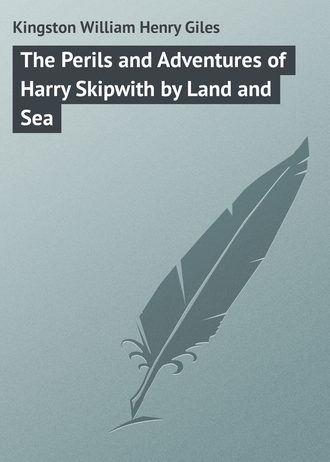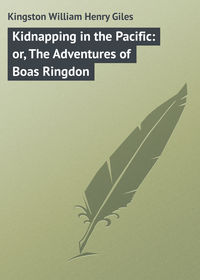 полная версия
полная версияПолная версия
The Perils and Adventures of Harry Skipwith by Land and Sea
Let me try and map-down this great country. Following up the course of the St. Lawrence across Lake Ontario, and passing over a broad isthmus, where a deep canal is to be formed, we reach lake Huron. Still going west some two thousand miles distant from the month of the St. Lawrence, we arrive at the Saulte St. Marie, where the waters of the great Lake Superior fall into that of Huron. Here is a free port, and a free settlement has been formed; but we have yet Lake Superior to cross, when we shall reach Fort William, in Thunder Bay, where the most western British American settlement has lately been established. From Thunder Bay, a spot of great picturesque beauty, a good map will show us a succession of lakes, joined by rivers, and known as Dog Lake, Lac des Milles Lacs, Rainy Lake, and Lake of the Woods, the chain, extending till the extensive Lake Winnipeg is reached, having again numberless other lakes and rivers farther west. A journey of about eighty miles beyond the extreme west of the lovely Lake of the Woods carries us to a settlement of British people; not of people who have cast off their allegiance to the British crown, but true subjects, who desire to live under British laws and institutions, and to enjoy all the privileges which Britons justly value as their birthright; yet it is not too much to say that no community of the British race is more completely debarred from the advantages possessed by Englishmen at large than are the inhabitants of the settlement in question.
A glance at our map will show us a river rising in the State of Minnesota, and running nearly due north, entering the British territory at the forty-ninth parallel of latitude, and finally falling into Lake Winnipeg. This is the Red River, and the British settlements on its banks are known as the Selkirk, or Red River settlements. Here are located about six thousand white inhabitants. The spiritual wants of the people have not been neglected, and a bishop, called the Bishop of Rupert’s Land, and about eight Protestant clergymen are placed there, besides a Roman Catholic bishop and several priests. The productions of the district are valuable and numerous, and the climate, though cold enough in winter to ensure a supply of snow, and very warm in summer, is healthy in the extreme, and admirably adapted to British constitutions. The Red River is navigable from the States to the settlements, and again thence to Lake Winnipeg, from which there is a ramification of water communication by lakes and rivers, navigable for steamers for many hundred miles.
The Hudson’s Bay Company have a strongly-fortified post at the junction of the Assiniboine and Red Rivers, called Fort Garry, which serves as the citadel or capital of the settlements, for town or village there is not. The general aspect of the country here is that of a rich level prairie, with the river cutting its way tortuously through it towards Lake Winnipeg, forming steep or cliff-like banks. Belts of trees, however, are to be seen near the river, and woods scattered about, and to the east ranges of hills, while along the sides of both rivers are homesteads, substantial farm-houses, mills, stores, churches, parsonages, and school buildings. These settlements are about four hundred miles west of Thunder Bay, in Lake Superior, and the country for this distance must be the first opened up, and about three hundred miles of it is by far the most difficult part of the undertaking; yet the engineering difficulties for forming such a road as is required are trifling compared to those which have been overcome in numerous works in Canada.
It is a country peculiarly of lakes, and rivers, and forests, the timber being very fine. The timber, by means of the lakes and rivers, can be carried to the settlements, while it is most valuable for the formation of the roads, dams, canals, and villages about to be constructed. I am speaking of the first three hundred miles of road to be formed, whether that road is by lake, river, canal, or on the firm earth. The great object is to get a way opened up with the greatest expedition and at the least expense. Now let us turn our eyes west of the settlements, and we shall see a belt of fertile land, in some places one hundred, in others fifty miles wide, extending for eight hundred miles, to the very base of the Rocky Mountains. This magnificent belt of land has already been traversed from one end to the other by exploring expeditions, and emigrant parties with carts, dragged by oxen travelling at the rate of twenty miles a day. It is intersected by many rivers. The carts were unladen, formed into rafts, and towed across; the cattle swam or waded. The once declared impassable Rocky Mountains were passed with perfect ease, in several places, and British Columbia entered.
To understand clearly the nature of the country, let us suppose ourselves standing on the banks of the Red River, looking west. In front we have the fertile belt stretching out before, us, consisting chiefly of rich level prairie land, ascending gradually towards the Rocky Mountains. Rivers and streams run directly across it at intervals, invariably lined with trees, and here and there are forests of considerable extent, though generally trees are found in small clumps or copses, covering a few acres, having escaped the ravages of the fires which destroyed the primeval forests.
On the left, running from west to east, there is the Assiniboine River, connected by the Calling River with the south branch of the Saskatchewan. On the right, extending in a north-easterly direction, is a range of wood-covered mountains known as the Riding, Duck, and Porcupine Mountains, and on the other side of these are three large lakes, the Winnipeg, Manitobah, and Winnepegosis. Into the northern end of the first falls the important river Saskatchewan, navigable by steamers for two or more hundred miles, and, with certain breaks, up to the very; foot of the Rocky Mountains. The Saskatchewan gives its name to the greater portion of the fertile territory, which is known as the valley of the Saskatchewan. This wonderful chain of rivers and lakes abounds in a great variety of excellent fish, on which once numerous tribes of natives entirely subsisted – so that they thus afford a never-failing supply of food, abundant irrigation, and extensive water inter-communication.
Compared with the latitude of the British North American Provinces, the climate may be supposed to be severe, but it should be understood that as the west is approached the climate improves, and the fact is that near the Rocky Mountains, farther north, and at a far greater elevation, the climate is not more severe than at the Red River. Thus there is uniformity of temperature and natural productions throughout the territory. The cold is great, but not greater than in Lower Canada, and sometimes the winters are so mild that, as Mr Ross, an old settler, states, he has known ploughs at work at Christmas. When spring begins, the heat becomes considerable; thus all the productions of the earth ripen with wonderful rapidity, and from sowing to harvest time is often but three months.
Professor Hind, of the University of Toronto, stated some years ago that the valley of the Saskatchewan, or rather the basin of Lake Winnipeg, contains an area available for cultivation of eighty thousand square miles – a territory very nearly as large as England – and that it is capable of supporting an agricultural population exceeding fifteen millions of souls. “The outlying patches of fertile land lying within the limits of the great plains, together with the deep, narrow valleys of the rivers which run through those arid regions (that is, to the south of the fertile belt), the east flanks of the Rocky Mountains, and the low lands in the region of the great lakes, might support another ten millions, so that the present available area of arable soil – the greater portion of which is susceptible of being at once turned up by the plough – would sustain an agricultural population equal to that of Prussia.” Indeed, vast as is Canada, the professor’s calculations show an excess of land fitted for the permanent abode of man, in favour of the basin of Lake Winnipeg over Prussia, before its recent accessions of territory, of five million five hundred thousand acres. If the whole quantity of land fit for cultivation in Canada were occupied, it would sustain a population of eighteen millions, while in the same proportion the territory under discussion would sustain nineteen millions of people. Including the Red-men, who slaughter the buffaloes which roam over its rich pastures for the sake of their skins alone, it scarcely now supports twenty thousand souls.
As to the natural productions of this region, it may briefly be stated to contain abundance of wood, stone, and clay for building; lignite in many districts, and coal in others; iron of excellent quality, in the neighbourhood of coal; salt, which has long been in use, the springs being easy of access; and grasses, which afford rich fodder in abundance throughout the winter season to large numbers of horses, and to many cattle. “Within the limits of the fertile belt vast herds of buffalo come in winter to feed and fatten on the rich natural grasses, which the early frosts in autumn convert into nutritious hay.” To sum up the capabilities of the territory: It is an admirable grazing country, and cattle and horses can remain out all the winter. Sheep thrive and multiply. Pigs, where there are oak woods, if turned out, require no looking after.
It must be understood that agricultural operations have for many years been carried on at the Red River, and round the mission-stations and trading-posts, and that the statements made are the results of actual experience. Wheat is the staple produce. The ordinary yield is thirty bushels to the acre, and oftentimes forty bushels. It is cut three months from the date of sowing. Indian corn is very fine, and never fails on dry lands. Root crops, especially potatoes, turnips, and beet, yield abundantly, and attain large dimensions. The potato disease is unknown. Garden vegetables grow luxuriantly, and equal those of Canada. Barley and oats, when cultivated with care, yield as abundantly as wheat. Of hay from the natural grasses an abundance can be made. Tobacco is successfully cultivated. Hops, in great luxuriance, grow wild. Ale is brewed with them at Red River. Hemp and flax have also been successfully cultivated. A variety of fruits grow wild, such as strawberries, raspberries, currants, and gooseberries; so does rice. Melons grown in the open air are very fine, and sugar, as in Canada, is abundantly obtained from the maple-tree.
Again, considering the abundant supply of fish, and the various sorts of game, large and small, from the buffalo and deer to the hare and rabbit, it will be understood how amply the territory is provided by nature for the support of a large population.
Of the Indians, there are scarcely forty thousand in the fertile belt and wood and lake regions together, who chiefly subsist on buffalo flesh and fish, and live in skin or birch-bark tents. The Prairie Indians have large numbers of hones, while only some tribes of the Wood Indians possess those animals. Some few have been converted to Christianity, but the larger proportion retain all their heathen customs, though generally they do not show any hostility to the whites. The Sioux Indians, however, across the boundary line, from the treatment they have received from the people of the United States, are determined enemies of the white men and half-breeds.
But how, it may be asked, can this vast territory be peopled? By a simple and easily carried out system. The object, in the first place, is to establish a direct communication across it. A railroad is out of the question for many years to come, and even a regular macadamised road can scarcely be expected for some time, but we may well be content if we can obtain a road over which a wheeled vehicle may travel some forty miles in the day, and horsemen at still greater speed. In the first instance, there must be settlements, and it is proposed to establish them at about twenty-five miles apart, in a direct line from Lake Superior to the Rocky Mountains. Grants of land with freedom from taxation, and the certainty of obtaining ample employment, will quickly attract settlers. In the first place, in each settlement a wheelwright and cart-builder, a blacksmith, two or more carpenters, a painter and glazier, a baker, a butcher, an innkeeper, and other artisans obviously required on a great highway, would find employment. Several farmers and agricultural labourers, and a market-gardener, would be wanted to supply food. Stable-keepers, and grooms, and postilions may be named, and all these would, of course, attract storekeepers, tailors, and shoemakers. A police force, with small bodies of military pensioners, and perhaps a few troops, might be stationed at intervals in the settlements along the line. To these communities, with the aid of some navvies, might be confided the duty of improving the road at first roughly marked out. Bridges might be required over small streams, and ferries would certainly be required over broad ones, and here boat-builders and ferrymen would be called for.
It will thus be seen in what way the settlements can first be formed; but before they are placed along the whole line, the more difficult part of the country between Lake Superior and the Lake of the Woods must be pierced through. Trees have to be cut down, rough places smoothed, and bridges erected; and where the line is by water, dams have to be constructed, landing-places formed, and steamers launched. Scarcely one summer, however, would be required for the work; and it must be remembered that the route in question has been traversed for years back, and that, although heavy luggage cannot at present be carried that way, passengers and light goods may be transported by canoes through the lakes and rivers which have been described. The first settlement has already been formed by the colonial government at Fort William, on Thunder Bay. About forty miles to the west is the boundary line between the British North American Confederation, which is destined ere long to include the whole of British North America, and the Hudson’s Bay Company’s territory.
Chapter Fourteen
From Toronto to the Pacific – Jack Trevor, an old Chum, for Fellow-traveller – From Collingwood by Steamer – Birch-bark Canoes – Lake Superior and Thunder Bay – Fort William to Lake Winnipeg – The Kaministiquia – Swiftfoot, our Indian Guide, and Half-caste Crew – A Portage – Our Camp and Progress – Missionaries and Settlers – Fort Garry and Selkirk SettlementsThere is nothing that I need relate excepting that after my arrival at Toronto I immediately set to work in right earnest about preparations for a journey of fifteen hundred miles or so across the continent to the Pacific. I had become intensely British during my stay in the States, and resolved that my journey should he, if possible, entirely through British territory, and remote as possible from the United States boundary. Some of my friends advised me to go by railway to La Cross, and from thence up the upper waters of the Mississippi to St. Paul, in Minnesota, then, by a stage to Georgetown, on the Red River, down which stream I could proceed by a steamer to the Selkirk Settlement, in the centre of which Fort Garry is situated, at the point where the Assiniboine and Red River meet.
When travelling I seldom fail to find a companion, and my disposition being somewhat of a malleable nature, I generally manage so to work his and mine together that we are able to rub on socially till called upon to separate. In the present instance I was more fortunate than usual, for, while I was in the midst of my preparations, who should turn up one day – or rather roll into the office of my cousin, John Brown – but my old school-fellow, and strong-fisted, stout-hearted friend, Jack Trevor, brother of Lieutenant Trevor of the Spitfire! He was a capital shot, could handle oar and scull right well, throw a fly skilfully, run like a deer, walk thirty miles on a stretch without fatigue, and woe betide the man who felt the strength of his arm! I told Jack what I was about to undertake.
“Just suit me,” he exclaimed. “I was wondering what I should do. I’ve a year or so to spare, some cash to throw away, am in good training, and should amazingly like to have a scamper after buffalo.”
The ice of winter having sufficiently disappeared from the upper lakes to render navigation possible we started by the northern railway, passing Lake Simcoe to Collingwood, on the shores of the Georgian Bay, and then embarked on board a steamer named after the same heroic admiral. Paddling away north, we were soon out of sight of the generally low shore, and then the wind began to blow and the waves to roll furiously, making the big vessel tumble about in a most uncomfortable manner, till I thought it more than possible that she would go down then and there to the bottom of the lake. Peter looked at me reproachfully, remarking —
“I thought when we got into this country we were to have no more tossing about on the salt ocean?”
“Nor have we. This is but a pool, Peter; the water is fresh, and the land is on every side of us, only we don’t see it,” I answered, but I doubt if he was satisfied.
We managed, however, to tumble on till we got under the lee of a wooded island, where we remained as quietly as in a mill-pond till the next morning, when we continued our voyage between the Manitoulin islands and the north shore of Lake Huron till we came to the Bruce mines.
Along this north shore a road has been surveyed and settlements laid out. Proceeding up the St. Mary River, we reached the villages of that name – one on the British, the other on the States’ side. Between the two Lake Superior sends its waters in a fierce rapid into the river on their course to the ocean. We avoided them by stealing through a canal on the American side. On our way we took on board two birch-bark canoes which my indefatigable cousin, John Brown, had caused to be provided, as, also, a supply of gum to stick over the seams, wattap, which is the root of the tamarack, used to sew the pieces of birch-bark together, cod-lines, and other indispensables for canoe navigation. Here, also, an Indian guide and a crew joined us – dark-skinned individuals descended from French Canadians and Indians, a class which is employed by the Hudson’s Bay Company – in their canoes. I will describe them as we go on. We purposed picking up, afterwards, a few Indians to increase our strength.
Away we steamed along the northern shore of Lake Superior, occasionally sighting some lofty bluff, said to contain a vast supply of iron, copper, and other mineral wealth, till we neared the fine headland of Thunder Cape and found ourselves amid the magnificent scenery of Thunder Bay. Here the steamer anchored; and we, launching our canoes, went on shore at Fort William, an important port standing at the mouth of the river Kaministiquia. We found that surveyors had already laid out a settlement on the banks of this stream, which is navigable for large vessels for a good many miles from its mouth.
While preparing for our long inland voyage of something not much under five hundred miles to the Red River, we were entertained by the surveyor, who showed us the plans proposed for opening up the country for general traffic. Trevor had become very eager on the subject, and declared that he should be ready to devote his life to the undertaking. We therefore agreed to follow the same route. Sending our canoes with the voyageurs up the Kaministiquia River, we were to proceed north along the shore of Thunder Bay till we reached a harbour abreast of Dog Lake, where we were to land and push our way for twenty-eight miles across the country, along the line where a good road was soon to be formed to Dog Lake. Here we were to embark in our canoes, as we should have a clear navigation of thirty-five miles across the lake and up Dog River till it became shoal; then, landing, we were to ascend to the height of land forming the boundary between Canada and the North West Territory, and make a portage of five miles to the Savanna River. A portage is literally a carrying. The canoes and cargo are carried on men’s shoulders over the land, either to avoid a rapid, or from one lake or stream to another; thus, these intervening spaces of land come to be called also portages. After launching our canoes in the Savanna River we were to obtain a free navigation of sixty-five miles, the Lake des Mille Lacs, and the river Seine to the Little Falls. We were, from this place, to be prepared for numerous portages, amounting altogether to seven miles, and fifty-nine and a half of navigation. After the last of these portages we were to get a run of two hundred and eight miles down the river Seine into Rainy Lake, and from thence into the Lake of the Woods, which we were to cross at its western extremity either to a small lake known as Lac Flat, ninety-one and a half miles across an easy country to Fort Garry, or to descend the Winnipeg River into Lake Winnipeg, and along its northern shore to the mouth of the Red River.
We decided on the latter route for ourselves, as we wished for our canoes to navigate the lakes and rivers to the westward, and, not being expected, we should have had no horses sent over by the Selkirk people to meet us. It must be remembered that the Selkirk settlement and the Red River settlement are different names for the same district, and that Fort Garry is in the midst of it. Trevor, who had an especial taste for engineering projects, was delighted with the account, and made out that by means of good steamers, short railroads, or even roads for coaches, and tramways over which loaded boats could be drawn, the distance between Fort William and Fort Garry might be accomplished in six days.
“You see,” he observed, “the greater portion of the distance would be performed by steamers; though, on the sixty miles of broken navigation on the river Seine, large boats to be dragged up inclined planes and along tramways over the portages would be more suitable. Then the Red River people would make the short road necessary between this place and Lac Plat, and supply the conveyances, greatly to their profit. Why, the whole route, if people had energy, might be open by next summer, and as we all know that the distance between the Red River and the top of the Rocky Mountains offers no impediments, if the inhabitants of British Columbia would open up a communication on this side, we should, in a year or two, be sending our letters across the continent from the Atlantic to the Pacific in a couple of weeks or so; and fellows like you or me, Harry, would be able to accomplish it by railway, steam-boat, and on horseback, in about the same time.”
Having sent the canoes on two days before, we supplied ourselves with packs, blankets, and provisions for a couple of days, and engaged an Indian guide, and landing at the mouth of Current River, on the northern shore of Thunder Bay, we worked our way along the line of the proposed road to Dog Lake. We just saved our daylight to the shore of the lake, where we prepared to camp. Our guide first cut off a quantity of the young shoots of the spruce-fir, which he strewed on a dry spot to form our beds, while, at his suggestion, we collected a large supply of dry wood for a fire. Our kettle for tea was soon boiling, and by the aid of our frying-pan, the most useful of all cooking utensils, the dried provisions we had brought with us were converted into a savoury stew, seasoned with garlic, salt, and pepper, and thoroughly enjoyed by us. Trevor pronounced it jolly fun, and declared that he should never grow tired of living as we then were doing. Never go across wild countries without a portable frying-pan, you can boil water in it, cool, boil, stew, fry, and even bake, without any other appliance than a frying-pan and a little fire and water. Our Indian guide, whose name was Swiftfoot, was so pleased with the way we treated him that he begged he might accompany us, and as he bore a good character for honesty and good temper and for being an expert and daring hunter and canoe paddler, we accepted his services. As he understood English fairly, and had already been a considerable distance up the Saskatchewan, we considered him a valuable acquisition to our party.
The next morning the canoes appeared. Having camped at no great distance from where we were, and having taken a hurried breakfast, we embarked.











